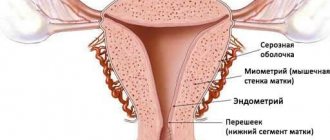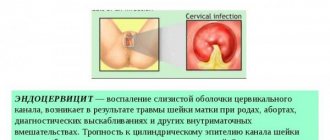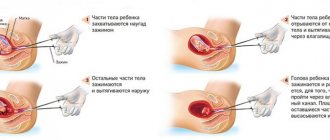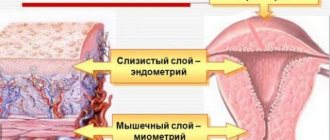Why do they do curettage?
For several reasons. Firstly, to do some research. The material taken is very valuable for diagnosis, especially if certain diseases are suspected. In this case, not only curettage of the uterine cavity, but also the cervical canal can be performed. Secondly, curettage is done to remove pathological formations, for example, polyps. Thirdly, this operation is sometimes necessary to eliminate complications after an abortion, miscarriage or (non-developing) frozen pregnancy.
Scraping can be done in two ways. The first method involves performing the operation blindly. The second involves the use of a special device, with which it becomes possible to examine the walls of the uterus both before and after the manipulation.
How does the curettage procedure take place?
This operation does not take long: it takes about 15-25 minutes. It is performed under general anesthesia: the anesthesiologist administers the drug intravenously. After administration, the woman immediately falls asleep. To ensure that the cervix remains motionless, the doctor inserts a gynecological speculum into the vagina and fixes it with a special instrument. Next, the cervix is dilated, and then the curettage itself is performed with an instrument called a curette. After completing the procedure, the cervix and vagina are treated with an antiseptic solution, and ice is placed on the abdomen to force the uterus to contract strongly and stop bleeding.
Treatment and rehabilitation after frozen pregnancy
After removing the frozen fetus and curettage, antibiotics are prescribed to prevent the development of infection, and drugs that help contract the uterus and stop bleeding.
After a frozen pregnancy, hormonal correction is carried out
To restore hormonal levels, hormonal correction is performed. For 3–6 months, combined oral contraceptives are prescribed, selected taking into account the age and other characteristics of the woman.
Rehabilitation after a frozen pregnancy includes:
- lack of physical and psychological stress;
- good nutrition;
- taking vitamins.
The loss of an unborn child is a great trauma. If possible, you should consult a psychologist, seek support from family and friends, do not withdraw into yourself and do not blame yourself for what happened.
When can you get pregnant after curettage?
If a woman has had an artificial termination of pregnancy, which involves removing the fertilized egg while simultaneously scraping the walls of the uterus, then the next pregnancy needs to be planned, taking many aspects into account. For example, the longer the pregnancy, the more serious the injury is caused to the body. How quickly it will recover depends on this, as well as on the woman’s health condition. As a result of an abortion, it is possible to develop inflammatory diseases, as well as depletion of the functional layer of the uterus, which, in turn, can lead to infertility, and in the case of pregnancy, to various complications. These include the threat of termination of pregnancy as a result of isthmic-cervical insufficiency or changes in hormonal regulation. In addition, the curettage procedure injures and thins the endometrium (the inner layer of the uterus), which can lead to improper formation of the placenta, the formation of adhesions and, as a result, to the attachment of the fertilized egg in the lower parts of the uterus. All this can cause an ectopic pregnancy or the development of placenta previa.
Based on the above, the doctor will give the go-ahead for pregnancy 3-6 months after the manipulation.
If curettage was performed due to spontaneous abortion, that is, miscarriage, or as a result of a frozen pregnancy, then before starting new attempts, not only time for rehabilitation is necessary, but also for numerous examinations. The fact is that in this case it is very important to establish the reason that led to miscarriage, so that during the next pregnancy a repetition of the situation can be avoided. As a rule, the recovery time in this case is slightly longer, from 6 to 12 months. During this time, not only the woman’s body rests, but both spouses can pass all the necessary tests. Both - because often the cause of a miscarriage can be a violation in the health of the man. If, as a result of the examination, a disease is revealed that needs to be treated with special potent drugs over a long period, then the timing of the next pregnancy may be delayed by the required time. As for non-developing pregnancy (the so-called intrauterine death of the fetus for up to 28 weeks), as a rule, there are several reasons: genetic, infectious, endocrine and autoimmune. It takes a sufficient amount of time to eliminate these causes.
Recovery time
We all have suffered various injuries at least once. These could be cuts, burns or fractures. Do you remember how long it took your body to recover? For example, a broken arm. It takes 4 to 8 weeks for the bones to heal and then the function of the arm to be fully restored. Trying to start loading your arm ahead of time can lead to dire consequences.
Approximately the same thing happens with a woman’s main reproductive organ, especially if the cleansing was associated with the termination of an undeveloped pregnancy. What happens in this case?
- Firstly, the body is under stress. Until recently, hormone levels and most of the work were aimed at preserving and developing new life. Now this need has disappeared, and the body must restore normal functioning.
- Secondly, any surgical intervention is always a burden, especially since the procedure involves the use of anesthesia.
- Thirdly, and this is most important, the inner surface of the uterus is one continuous wound. During cleaning, the mucous layer – the endometrium – is completely removed. This can be compared with menstruation, with the exception that during menstruation, the mucous layer is gradually rejected under the influence of the hormonal work of the body. And curettage is a “violent” way to cleanse the uterine cavity. Theoretically, the endometrium, after cleaning, is restored within one menstrual cycle (as with menstruation). However, one should take into account the complexity of the procedure, which means that the endometrium will be damaged somewhat more and will require a little more time to recover.
For the first 2-4 weeks after cleansing, you must refrain from sexual intercourse, physical exercise, and hypothermia. At this time, intensive restoration of the body and healing of the inner surface of the uterus occurs.
If you do not maintain sexual rest at this time, the chance of infection increases. For example, due to the weakening of the body’s immune forces, opportunistic microorganisms such as staphylococci may begin to multiply intensively. The introduction of E. coli is not excluded. If they reach the uterine cavity, they will find themselves in ideal conditions for life. As a result, endometritis may develop.
As a rule, after the curettage procedure, a course of antibiotics is prescribed to prevent the development of complications after the operation.
Therefore, in the first 15-20 days it is necessary to maintain sexual rest and carefully monitor hygiene.
It may take 3 to 6 months to restore a regular menstrual cycle. During this entire period, it is recommended to use contraception during sexual intercourse. This may be a condom, but more often women are prescribed oral contraceptives.
If you do not wait at least the minimum period, 3 months, and conceive a child, then it is very difficult to guarantee a normal pregnancy. The main danger is that the endometrium has not yet “grown” to the required thickness, and the level of hormones in the woman’s blood has not stabilized. A too thin mucous layer of the uterus will not allow the fertilized egg to fully attach and, as a result, an early miscarriage will occur.
So, waiting 3-6 months after cleansing is not a whim of doctors, but a necessary period of time for the body to recover. It’s better not to take risks, but to wait a little. And then the pregnancy will develop well and end with the birth of the long-awaited baby.
You should know that the recovery of the body depends on the timing of the interrupted pregnancy. If the gestation period is short (up to 7 weeks), then the recovery period is significantly reduced. If the pregnancy exceeded 8-13 weeks, then it takes much more time to restore the body.
In any case, you should consult your doctor about the timing of pregnancy planning, because only he has all the information about your specific case.
When can you plan to get pregnant after cleansing?
The gynecological procedure of curettage of the uterine cavity is popularly called cleansing. Many women ask whether pregnancy is possible after cleansing and when they can start planning.
Most experts are confident that conception can happen in the next cycle, but the body most likely will not be ready for pregnancy. It is necessary to give it time to recover, taking into account the causes and consequences of cleaning, so that nothing interferes with the normal conception and bearing of a child.
Why is curettage done and how does it happen?
Curettage of the uterus is a gynecological procedure during which its contents, including the superficial mucous layer, are removed. Cleaning is carried out in a hospital setting using local or general anesthesia. Curettage is considered a full-fledged surgical operation that requires appropriate preparation.
Before the procedure, the doctor must know exactly the purpose of curettage and the presence of contraindications to the operation in the patient. Cleaning is carried out using special gynecological instruments: vaginal speculum, blunt and sharp curette, uterine probe, dilators for the cervix, etc.
How long does the recovery process last after cleaning?
Recovery after uterine curettage lasts from 6 to 12 months, depending on the reason for the intervention. During the postoperative stage, a woman should carefully monitor changes in the body.
First of all, this concerns discharge from the genital tract, which may be the first to signal the development of complications. Uterine bleeding after the curettage procedure lasts no more than 10 days; in nature, it resembles menstruation with accompanying nagging pain in the abdominal area.
If the bleeding stops ahead of schedule, that is, the discharge lasts no more than 2 days or does not appear at all, you should immediately inform your doctor. Most likely, we are talking about a hematometer - a violation of the discharge of secretions from the cavity of the reproductive organ, caused by spasm of the cervix. Attention should also be paid to discharge that has an unpleasant odor and color. In this case, we may be talking about the addition of an infection.
After curettage, the woman needs to undergo tests to diagnose the causes of spontaneous abortion or missed abortion.
These studies include:
- determination of hormone levels (estrogen, progesterone);
- a smear on the vaginal microflora to confirm or exclude sexually transmitted infections;
- Ultrasound of the pelvic organs;
- histological examination of tissue obtained during curettage.
Often, after cleaning, a woman feels pain in the pelvic organs during menstruation. This is a fairly common phenomenon, which is caused by congestion in the uterus. Antispasmodic drugs, for example, No-shpa, will help prevent them. It effectively relaxes the walls of the reproductive organ and the cervix, facilitating easier discharge of accumulated blood discharge.
After the curettage procedure, antibacterial therapy is usually prescribed, aimed at preventing infection of the genital tract and uterus. If after cleansing a woman is bothered by heavy bleeding, a specialist may prescribe Oxytocin injections and a course of treatment with water pepper tincture. Within 14 days after curettage, it is prohibited to engage in sexual relations.
To quickly undergo rehabilitation after cleansing and reduce the likelihood of miscarriage in a subsequent pregnancy, a woman is recommended to adhere to the following rules:
- give up bad habits that interfere with healthy conception and childbearing;
- take multivitamins, eat right;
- do not expose yourself to stress, both physical and mental.
It is also important to mentally tune in to a successful outcome, since negative thoughts and bad mood can negatively affect a woman’s overall well-being.
Who is at risk for recurrent miscarriage?
Women who have undergone induced abortions in the past have a second chance of experiencing a non-developing pregnancy. And the more of these abortions there were, the higher the risk of fetal death.
Also, this diagnosis is encountered by patients who have a history of ectopic pregnancy or the birth of a non-viable child who died in the womb shortly before birth.
This group also includes women who suffer from infectious and inflammatory diseases of the genital area (for example, genital herpes). In addition, the risk of another unsuccessful pregnancy increases with age, so all women are recommended to give birth to their first child no later than 30 years of age. Read more about late birth →
Chronic difficulties with pregnancy may arise due to anatomical problems in the woman’s reproductive system. For example, with a bicornuate uterus. The altered structure of the organ prevents the normal attachment and development of the fertilized egg, so the chances of becoming pregnant and carrying a child to term even after 2 missed pregnancies in such a patient will be negligible.
The presence of uterine fibroids will also be an obstacle to the normal development of the embryo. The tumor deforms the uterine cavity, interfering with the proper implantation of the fertilized egg and its subsequent development.
Repeated non-developing pregnancies are observed with disorders of the endocrine system, such as diabetes mellitus, thyroid disease, menstrual irregularities, and insufficient progesterone synthesis.
When can you plan a pregnancy?
It is not recommended to plan pregnancy immediately after cleansing. The inner layer of the uterus after curettage is similar to a wound surface that is just beginning to heal. It is necessary to give the body some time to recover. During the rehabilitation period, you must take antibiotics and antifungal drugs, and abstain from sexual activity for at least 3 weeks.
Subsequent pregnancy planning after cleaning is completely dependent on the cause of curettage. For example, if the cleaning was aimed at removing a frozen pregnancy or parts of the fertilized egg after a miscarriage, then you can plan a new conception six months or 6 cycles after the operation. This is important for the rehabilitation of the hormonal levels of the female body, which has suffered a serious shock due to spontaneous abortion.
Before planning a pregnancy, it is important to find out the reason for the failure and determine why the abortion occurred. The reasons may be infectious and inflammatory factors, stress, sexually transmitted infections, hormonal imbalances and much more. Before planning a new pregnancy, it is important to exclude negative factors that preceded the previous conception.
If curettage was performed to remove a polyp or endometrial hyperplasia, pregnancy can be planned earlier - 2 months after the operation. In this case, the woman’s body has not experienced serious hormonal stress, so the consequences of cleansing should be minimal.
Causes
Spontaneous termination of pregnancy in the early stages can occur in an apparently completely healthy young woman. This may be the first pregnancy following a medical abortion, miscarriage, or normal childbirth. It is based on fetal death due to various reasons and factors.
Spontaneous abortion can happen for various reasons, but the most common causes are:
- abnormalities of embryo development incompatible with the further development of pregnancy;
- the presence of chronic serious diseases in the body;
- severe iron deficiency anemia;
- lifting weights or intense sports;
- a history of frequent pregnancies, as a result of which the body simply cannot cope with the load;
- hormonal insufficiency, in particular the production of progesterone in small quantities;
- immune incompatibility of woman and fetus (Rh conflict);
- isthmic-cervical insufficiency, as a result of which the cervix at a certain period cannot cope with the growing load and the pregnancy is terminated;
- hidden sexually transmitted infections;
- installed intrauterine device;
- the influence of teratogenic factors (irradiation, taking antibiotics and other medications, undergoing a course of chemotherapy, alcohol abuse and others).
The most common cause of termination of pregnancy is pathology of fetal development, when the fertilized egg dies in the first days after conception due to genetic pathologies. The number of embryo development abnormalities increases with age, so even in the absence of somatic diseases, infections and other factors, doctors recommend that women give birth at the age of 20–28 years, and not delay planning pregnancy. With age, not only the risk of spontaneous miscarriages, missed abortions, anembryonia, but also the birth of a sick child, for example, with Down syndrome, increases.
The second most common cause of miscarriage is chronic genital tract infections. Moreover, the infectious agent can act both directly on the fetus and cause disturbances in the genital organs that prevent normal pregnancy. For example, infection with cytomegalovirus leads to anembryonia, abnormalities in the formation of the central nervous system of the fetus and other defects incompatible with life. If a woman experiences several spontaneous abortions in a row, then gynecologists diagnose recurrent miscarriage.
What to do if a spontaneous abortion occurs? Does infertility develop after this? When can you get pregnant after a miscarriage? Women often ask their doctors all these questions. The answers to them depend on the functional state of the female reproductive system.
Conception after curettage
According to doctors, a new pregnancy after cleansing can occur quite quickly. Already in the first cycle after the intervention, many women can conceive a child. But doctors strongly do not recommend rushing into pregnancy, as the body needs time to rehabilitate.
Most doctors adhere to standard recommendations for women who have undergone cleansing: avoid sexual intercourse during the first cycle, use contraceptives for 6 months to prevent pregnancy. Next, you can plan to conceive.
Women who have undergone curettage due to a non-developing or frozen pregnancy have the greatest chance of becoming pregnant after cleansing. If the cleansing was performed with the aim of terminating an unwanted pregnancy, then you need to use protection from the first sexual intercourse, otherwise the chances of conceiving after an abortion are higher than for other reasons for curettage.
If pregnancy occurs in the first two cycles after cleansing, the situation can bring a lot of trouble to the woman, since abortion in such a situation is a contraindication. You need to consult your doctor. There are many examples of successful pregnancy after curettage, but there are also many known cases where, under the same conditions, pregnancy caused serious complications.
How to take care of yourself after the procedure?
About half of women who have miscarriages do not need this method of abortion. However, if it occurs after 10 weeks, it is likely to be incomplete and will require surgery.
Dilation and curettage is a two-step medical procedure that is usually performed after a first trimester miscarriage. This involves widening the cervix (dilatation) and clearing it of useless tissue by scraping the uterine wall with a curette (curettage). Vacuum aspiration (also known as mini-abortion) may also be used. This is done using a manual or electric special pump.
Each woman can independently decide whether to wait until the body gets rid of unnecessary tissue on its own or resort to a surgical procedure. If you choose the second option, you must consult your doctor to refer you to the hospital. General anesthesia is generally used, but local anesthesia may sometimes be prescribed. If there are no complications or other health problems, you may be discharged from the hospital within a few hours after the curettage.
Self-care at home
- Most women can return to their daily activities within a few days. Some even feel comfortable enough to resume their activities (without overexertion) the next day.
- You may experience painful cramping at first, but this should subside within 24 hours. Mild pain and bleeding are normal for a few days to two weeks after the procedure. Ibuprofen is usually prescribed to relieve pain.
- You should not insert anything into the vagina. Avoid bathing or sexual activity for at least 2 weeks or until bleeding stops. Your doctor will tell you when you can have sexual intercourse. Do not use tampons until your next period, which may occur 2 to 6 weeks after curettage.
- It is unknown when the next ovulation will occur. Once you resume sexual activity, use some form of contraception until your doctor says it is safe to start trying to get pregnant again. Visit your gynecologist regularly after the procedure.
When should I consider another pregnancy after curettage?
If you want to get pregnant after a miscarriage, talk to your doctor. Find out when you can start trying for your next pregnancy. Most experts will advise you to wait three menstrual cycles after the procedure before resuming them. This period is necessary for the uterus to recover from the intervention and to recover from the stress and emotional trauma of losing the baby.
Avoid trying to become pregnant before you have had at least one menstrual cycle after the procedure. The first period after curettage is usually late, and a home pregnancy test is often positive. As soon as menstruation begins, most women tend to think that they have experienced another miscarriage, when in fact it is the consequences of the first miscarriage.
What is fading
Freezing is a pathological phenomenon in which the fetus in the womb stops developing
(dies).
It is wrong to call the curettage procedure an abortion in this situation. Abortion is a term that involves taking away the life of a fetus by removing it from the womb.
In case of freezing, the doctor removes the already dead fetus.
Refusal to cleanse in the hope of saving the child leads to serious consequences.
The dead fetus decomposes, toxins penetrate into the blood through the umbilical cord, and after damage to the placenta, the risk of suppuration of the female reproductive organs and abdominal cavity increases significantly.
Rotting spreads through the tissues and the only way out is removal. A complete transfusion can sometimes prevent blood poisoning.
The timing of the cleansing affects when you can become pregnant after a frozen pregnancy. If the diagnosis was made late, the rehabilitation process is significantly delayed, not to mention cases of resulting infertility.
In the first trimester, toxicosis is confused with symptoms of fading and people seek help late. In case of severe physical condition, it is recommended to do a simple blood test
, which will show fading.
Infertility after a frozen pregnancy
Infertility after a missed pregnancy is quite rare. It may occur due to incorrect or late treatment of factors that provoked freezing, or genetic prerequisites.
Another cause of infertility can be an unsuccessful operation to remove a frozen fetus and curettage of the uterus, which damages the germinal layer of its mucous membrane. Fortunately, the probability of such an outcome is very low, but it still exists.
Consequences
In the early stages, curettage is replaced by vacuum cleaning
. A tube is inserted into the uterus, which, like a vacuum cleaner, sucks the embryo into itself. The method is safe up to 11 weeks of pregnancy.
After 11 weeks, curettage is used - the entire layer of the endometrium, with the attached fetus, is torn off from the wall of the uterus.
After curettage during a frozen pregnancy, a woman will experience a number of characteristic symptoms:
- vaginal bleeding;
- discharge;
- lower abdominal pain;
- pain in the mammary glands;
- temperature increase;
- depression.
Curettage is a wound in the uterine cavity. As long as the top layer does not heal, blood discharge does not cause suspicion. Normally, bleeding is not too heavy, without additional aggravating symptoms, and lasts up to 4 days.
Vaginal discharge can be brown or yellow. Brown spots up to 2 weeks after curettage are considered normal. This could be clotted blood coming out of the healing uterus.
After 14 days, such discharge is not considered normal. Yellow discharge is a sign of an inflammatory process.
Pain in the lower abdomen is caused by a wound and contraction of the uterus to its natural size.
Contraction is painful because hormonal levels are disrupted and the process does not go as smoothly as after childbirth.
Hormonal changes also affect the condition of the breast. The process of preparing for feeding has already begun, and a sharp reverse motion causes natural pain in the tissues.
Temperature increase
normal in the first days, but its growth must be monitored and the appearance of additional symptoms monitored. Inflammation could occur.
The emotional state of a woman who has lost a child is difficult to describe in words and convey. It's terrible.
Causes and manifestations of frozen pregnancy
A frozen pregnancy (silent or incomplete miscarriage) is a rare type of miscarriage when the body is unable to recognize the death of the child in the womb, as a result of which it cannot expel the pregnancy material. Because of this, the placenta may continue to secrete hormones, causing the woman to still experience all the other symptoms of being pregnant.
The main cause of missed abortion is a chromosomal abnormality of the fetus. The presence of such an anomaly causes inhibition and ultimately cessation of the child’s development in the womb. Approximately 1% of all pregnancies end in silent miscarriage.
Most incomplete miscarriages occur within the first 12 weeks after conception. They are usually identified during regular checks. For example, during an ultrasound, a specialist can identify an underdeveloped fetus. Or, if the fetal heart rate is not heard during echo-Doppler testing, this indicates fetal death. If an ultrasound is performed. The miscarriage is then confirmed using ultrasound.
A frozen pregnancy, as a rule, does not manifest itself in any way. Many women do not realize that the baby has died in the womb and most often do not experience any symptoms such as severe cramping, vaginal bleeding or expulsion of fetal tissue. This is due to the same release of pregnancy hormones by the placenta, which play a role in the continuation of pregnancy symptoms.
Some women, however, notice a decrease in pregnancy symptoms with an incomplete miscarriage. Others may have reddish or brownish vaginal discharge. Often, after the death of a fetus with chromosomal abnormalities, the body can begin to miscarry within a few days. When it becomes clear that a miscarriage is not occurring naturally, the obstetrician has several options for terminating the miscarriage.
Complications
Complications after curettage
not news. The most common ones are:
Endometritis is an inflammatory process
endometrium of the uterus. During the operation, or because the woman does not comply with the rules of the postoperative period, foreign particles enter the uterus and the tissues become inflamed. The disease is accompanied by fever, discharge and pain. The chronic stage of the disease is characterized by infertility, since the egg cannot penetrate into the inflamed endometrium and reliably attach.
An ovarian cyst is a cavity in the ovary filled with fluid. This is a reaction of the hormonal system to the abrupt termination of pregnancy.
Depression is a very complex disease. It can lead to mental disorders, destroy a marriage, and lead a woman to self-destruction. Impressionable people and ladies who have been waiting for a baby for a long time are especially susceptible to deterioration of their condition. It is very important to undergo training and consult with specialists. The state must not be started under any circumstances! Advanced depression very often leads to suicide!
Recovery
Recovery after curettage of a frozen pregnancy is a long process.
, taking place in 3 stages:
- bring the body back to normal after the procedure;
- undergo a course of treatment to eliminate the problem that caused freezing;
- accumulate strength to conceive again.
Recovery of the endometrium after curettage may take 2 months.
It depends on individual characteristics, hormonal background, immune system and the presence/absence of complications.
One of the signs of successful recovery is menstruation. They show that the hormones are working “as intended” and their quantity is sufficient.
The very fact of menstruation shows that the endometrium has grown and moved away naturally. Full recovery may take up to 2 menstrual cycles.
Delayed menstruation after curettage
Normally it is up to 45 days if it is not accompanied by additional symptoms:
- pain;
- strange discharge;
- unpleasant odor;
- heat.
Additional symptoms or a delay of more than 45 days indicates deviations
in hormonal background, inflammatory processes or remnants of the fertilized egg.
New pregnancy
Pregnancy after a frozen pregnancy must be approached with all responsibility! Necessary:
- fully recover after the procedure;
- find out the cause
of the pathology; - undergo a course of treatment;
- prepare the body for a new conception.
The first question that arises in a woman after curettage is whether it is possible to get pregnant after a frozen one? The answer is yes, but there are conditions:
- curettage must be carried out on time so that suppuration does not have time to affect the uterus and all reproductive organs remain healthy;
- establish and eliminate the cause of the fading;
- hormonal levels must correspond to standards;
- endure the rehabilitation course and not become pregnant until its completion;
- undergo a course of recovery from psychological trauma, if necessary. Morale is very important and can cause miscarriage or death.
An important point - when can you get pregnant after a frozen pregnancy? The recommended period is to withstand from one to two years,
depending on individual characteristics.
During this period, the body will probably recover, you will be able to get rid of all bad habits, your diet will improve, and your hormonal levels will return to normal.
The second important aspect is how long before you can prepare for re-fertilization? After half a year - not earlier.
In 6 months, most pathologies leading to freezing are cured, or most of the course of their treatment is completed. The overlap of courses of therapeutic and preparatory therapy can lead to undesirable consequences.
Preparing for pregnancy
after frozen suggests:
- quit bad habits;
- get out of depression;
- take vitamins;
- lead a healthy lifestyle;
- watch your diet.
Analyzes
Examination after a frozen pregnancy is very important.
Firstly, it allows you to monitor a woman’s health status and prevents possible diseases from developing to a critical stage.
Secondly, establishing the causes of the tragedy will help in the future to successfully become pregnant after a frozen pregnancy and carry the baby to term.
List of main studies:
- Ultrasound;
- hormone analysis;
- STD testing;
- immunogram;
- histological examination;
- microflora smear.
An ultrasound is performed on the 10th day after cleaning to confirm that there are no particles of fertilized egg left in the uterus. If there are particles, repeat cleaning is prescribed, otherwise inflammation and suppuration will begin.
Hormone analysis is necessary for 2 reasons: to determine the current condition, and to prescribe a course of hormones to maintain the body, because not every woman’s hormonal levels balance out on their own. In the future, the hormonal background will show whether a deviation in his work was the cause of the freezing. The second analysis is done later, when the body is restored and the woman begins to think about conceiving again.
STDs are sexually transmitted diseases. They cause pathologies in both the mother and the fetus, which leads to freezing.
An immunogram is an analysis of the functioning of the immune system. Failures in its operation lead to freezing. The analysis is carried out in the late period of rehabilitation.
If a woman is not recovering well, an immunogram may be needed to determine her current condition and prescribe the correct treatment.
Histological examination - examination of the fetus
for the presence of developmental pathologies. The result in the future will help you get pregnant safely and carry a child to term.
It is carried out in the first days after cleaning. It is recommended to notify doctors in advance about the need for it.
A microflora smear determines the woman’s current condition and makes it possible to identify a number of diseases that provoke fading. This knowledge is necessary for successful treatment and preparation for a new conception.
Recommendations
Recommendations after curettage boil down to strict adherence to the doctor’s instructions
. Each case is individual, with a unique “set” of complications and consequences.
General advice includes temporary (until the gynecologist's permission) prohibitions on:
- sexual contact;
- use of sanitary tampons;
- douching;
- taking baths and visiting the pool;
- hypothermia;
- heavy physical activity and heavy lifting;
- pregnancy in the first six months
after cleansing.
Penetration of any foreign object, including water, into the vagina and hypothermia are fraught with inflammation. Physical activity tones the uterus - this means pain and possible bleeding. It will not be possible to carry out an early pregnancy, and the body will “remember” the reaction even better.
Pregnancy after curettage of a frozen pregnancy is feasible and occurs in 9 out of 10 cases. It is very important to allow your body to fully restore its strength, and not to rush things.










